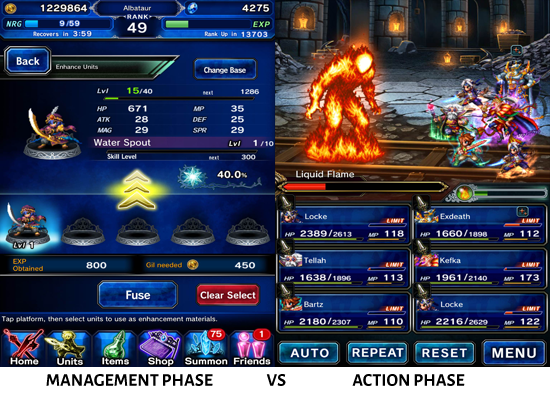Our old friend the Action Phase
For mobile and the freemium model, we need to keep an open mind about the action phase. Its role is changing. The action phase should now be a clear identifier of needs.

With the coming of the mobile phone and the freemium model, games have evolved a lot. When making a game, some of the old truths are painfully giving ways to new ones. Minds need to open up about one old friend: the action phase.
What is the Action Phase
I define the action phase as the phase of the game where there is gameplay or visualization of gameplay. This would be the phase where the user can be the most active. This could also be defined by opposition to the management phase, where the user can take his time getting ready and making adjustment in order to succeed in the action phase. In a sport game, the action phase would be playing a match while the management phase would be managing the team, buying new gear. In a game like Clash of Clan, management phase is when you build your town and train your troops, the action phase when you attack another player. Some games are only action phase (most platformers), some only management (most city builders), but a lot of them have both.

Now that we defined the action phase, we can destroy it! When building a mobile game, you must forget almost everything about the action phase of console and pc games. Mobile is all about quick and not continuous, which doesn’t work well with intense and long gameplay. You must accept that your action phase could be done without the input of the user. It is very weird for some that you would build a game that you actually don’t play. But the fun factor actually shifted from the action phase to the management phase. Hence the plethora of game embracing the auto-mode model.
Defining the needs
So if you don’t get to play your action phase what do you need it for? Well what the user wants when he plays this sort of game is progression and the action phase is a very good visualisation of progression. Also, if done right, your action phase will identify, to the user, progression blocker. In order to complete certain challenges / puzzles in the gameplay, he will need certain puzzle pieces (needs). These needs should have ways to be fulfilled in the management phase. Different game modes should have different needs, creating multiple projects for your user. A player that feels he has a lot of interesting and rewarding projects to complete has more chance of staying longer in your game (KPI Retention).
Depending on the effort needed to complete the action phase, the user should also be given an adequate reward. This complete the trinityof the action phase. The In is the Need, the action phase itself is the Effork / Work and the Out is the Reward. If your game is built right the Reward of a game mode is the Need of another one, creating a chain of action phase very clear to the user.
We need to keep an open mind with the shifting model and understanding the new action phase will help us create more successful mobile games. By making the action phase a clear identifier of needs, we create a clear path and project for the user that can be translated into a monetisation opportunity. By fulfilling the need for rewarding progression of the user and creating interesting monetisation paths, we have all the ingredients for a successful game. If I have one sentence to leave you with it would be this one: the action phase should be a clear identifier of needs.
Read more about:
BlogsAbout the Author(s)
You May Also Like







.jpeg?width=700&auto=webp&quality=80&disable=upscale)








